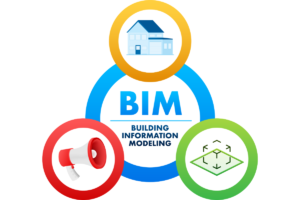In recent years, Building Information Modeling (BIM) has transformed the architecture, engineering, and construction (AEC) industry, enabling professionals to design, construct, and manage buildings more efficiently. However, as BIM has evolved, so has the terminology that accompanies it. For those new to BIM or looking to deepen their expertise, understanding core BIM terms is essential. These terms provide a framework for grasping the concepts, tools, and processes that define BIM workflows, enabling smoother collaboration, minimizing errors, and driving project success.
BIM terminology goes beyond technical jargon; it encapsulates a language that connects diverse project stakeholders, from architects and engineers to contractors and owners. Familiarity with key terms helps professionals align on expectations, communicate effectively, and utilize BIM to its full potential. Whether you are just beginning with BIM or are a seasoned professional aiming to refine your knowledge, a clear understanding of these foundational terms can enhance your ability to navigate and contribute to BIM-based projects.
In this article, we will cover the top 10 BIM terms that every AEC professional should know. Each term will be explained in context, illustrating its importance and application in BIM workflows. By the end, you’ll have a solid grasp of essential BIM terminology, empowering you to engage confidently in BIM-centered projects and stay current in an industry that’s continuously innovating.
Building Information Modeling (BIM): The Core Concept Explained
At its foundation, Building Information Modeling (BIM) is a digital process that involves creating and managing 3D models of buildings and infrastructure. Unlike traditional 2D designs, BIM models capture not only the physical aspects but also the functional characteristics of a building, allowing a collaborative and data-rich approach to design and construction. BIM brings together architecture, engineering, and construction stakeholders on a unified platform, improving decision-making and providing a reliable foundation for each phase of a building’s lifecycle, from initial design to maintenance.
LOD (Level of Development): Defining Detail in BIM Models
Level of Development (LOD) defines the extent of detail and precision within a BIM model at various stages of a project. It ranges from simple geometric representations (LOD 100) to detailed as-built models (LOD 500). Each level reflects a progression in model fidelity, ensuring that all stakeholders understand the depth and reliability of data at any given point. LOD provides a structured approach to managing information in BIM, clarifying expectations and ensuring that each model serves its purpose effectively throughout the project’s lifecycle.
Clash Detection: Ensuring Design Compatibility in BIM
Clash detection is a critical component of BIM that identifies and resolves conflicts or “clashes” between different building elements, such as HVAC systems and structural beams, before construction begins. By using clash detection software, project teams can visualize and address these issues early on, avoiding costly delays and rework on-site. Clash detection improves collaboration across disciplines, fostering smoother project execution and contributing to more accurate project timelines and budgets.
4D and 5D BIM: Integrating Time and Cost into Modeling
4D and 5D BIM extend traditional 3D modeling by adding time (4D) and cost (5D) dimensions, transforming BIM into a comprehensive project management tool. 4D BIM connects the construction schedule to the model, allowing for simulations of the construction sequence over time. Meanwhile, 5D BIM links cost data, enabling budget tracking and cost forecasting. Together, these dimensions offer insights that support efficient project planning and resource management, helping stakeholders make informed decisions and optimize project timelines and budgets.
Common Data Environment (CDE): The Centralized Data Hub
The Common Data Environment (CDE) is a shared digital space where all project information is stored, managed, and accessed by authorized stakeholders. A CDE streamlines collaboration by serving as a single source of truth for documents, drawings, and models, ensuring that all team members work with the latest information. By reducing discrepancies and promoting transparency, the CDE enhances project quality and efficiency, allowing for real-time collaboration and smoother project execution.
IFC (Industry Foundation Classes): Enhancing Interoperability in BIM
Industry Foundation Classes (IFC) is an open, vendor-neutral file format designed to improve interoperability between different BIM software platforms. IFC enables seamless data exchange and collaboration across the AEC industry by standardizing how information is shared, allowing teams using different software to work together effectively. IFC is crucial in large-scale projects involving multiple stakeholders, as it ensures compatibility and reduces the risk of data loss or misinterpretation.
Digital Twin: The Real-World Reflection in BIM
A digital twin is a virtual replica of a physical building or infrastructure asset, continuously updated with real-time data. In BIM, digital twins integrate information from the model with data from sensors and IoT devices, enabling real-time monitoring, predictive maintenance, and enhanced facility management. This technology allows professionals to test scenarios, forecast outcomes, and optimize performance, transforming the way we interact with and manage physical spaces over their lifespans.
BIM Execution Plan (BEP): Setting Guidelines for Project Success
A BIM Execution Plan (BEP) is a strategic document outlining how BIM processes will be implemented on a specific project. It includes standards, workflows, roles, responsibilities, and objectives, ensuring that all project participants understand the scope and goals of BIM usage. The BEP establishes a roadmap for efficient BIM execution, serving as a guide for coordination, data sharing, and quality control throughout the project.
Scan to BIM: Converting Physical Spaces to Digital Models
Scan to BIM is a process that uses 3D laser scanning or photogrammetry to capture precise data of existing buildings or structures, which is then converted into a digital BIM model. This technique is valuable for renovations, retrofits, and facility management, as it provides highly accurate models of existing conditions. Scan to BIM saves time and reduces errors in remodeling projects by eliminating the need for manual measurements, allowing professionals to work with up-to-date, precise data.
COBie (Construction Operations Building Information Exchange): Managing Facility Data Efficiently
COBie is a standardized format for organizing and exchanging building asset data within BIM models. It focuses on capturing non-graphical information—such as equipment lists, warranties, and maintenance schedules—that is essential for facility management. By structuring data in a format that can be directly used by facility managers, COBie streamlines the handover process, ensuring that all necessary information is easily accessible for ongoing maintenance and operations.
Each of these terms plays a vital role in BIM, providing professionals with tools and guidelines to optimize project outcomes, improve collaboration, and streamline workflows. Through the integration of these concepts, BIM enables more sustainable, efficient, and cost-effective project management and building operations.
How BIM Terminology Enhances Collaboration and Project Success
Mastering BIM terminology is more than just acquiring a new vocabulary—it’s about understanding a framework that underpins collaboration, efficiency, and innovation in the architecture, engineering, and construction (AEC) industry. As BIM continues to evolve and integrate more advanced technologies, knowing the essential terms allows professionals to leverage the full potential of BIM, aligning teams and improving project outcomes.
From foundational concepts like Building Information Modeling (BIM) and Level of Development (LOD) to advanced tools like Digital Twins and Scan to BIM, each term represents a building block in the BIM ecosystem. These terms enable clearer communication and more seamless collaboration, ensuring that everyone involved in a project—from designers and engineers to contractors and facility managers—has a shared understanding and a unified approach. This shared vocabulary minimizes misunderstandings, helps manage expectations, and supports the timely resolution of potential issues.
By staying current with these core BIM terms, AEC professionals position themselves to drive project success, reduce costs, and deliver higher-quality results. As the industry moves toward increasingly data-driven and sustainable practices, proficiency in BIM language not only makes professionals more effective team members but also opens doors to greater career opportunities in a competitive field. Ultimately, BIM terminology empowers AEC professionals to navigate projects confidently, create resilient and efficient buildings, and contribute to a more innovative future in construction and design.





